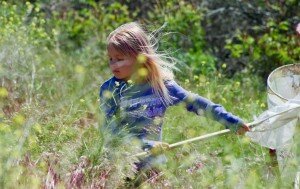
Citizen scientists play an important role in conducting surveys and battling invasive species on our national wildlife refuges (image: BioBlitz 2010, Deer Flats NWR, Robert G. Allen)
Even in times of robust funding, our national wildlife refuges rely heavily on volunteers, who perform an estimated 20 percent of the work done in the nation’s 553 refuges. One key need is the monitoring of refuge resources, yet currently the U.S. Fish and Wildlife Service (FWS) does not have the funding or the staff required to do all the inventory and monitoring work needed.
Can the vision process jumpstart a discussion on how to use Landscape Conservation Cooperatives (LCCs) help citizen scientists to play an increasingly important role in helping the FWS address climate change and land conservation at a landscape scale?
Currently, there are a variety of “citizen science” programs. The FWS is a partner in the USA National Phenology Network, a program that brings together citizen scientists, government agencies, non-profit groups, educators and students to monitor the impacts of climate change on plants and animals in the U.S. Observers report recurring plant and animal life cycle stages, information that helps scientists identify and understand environmental trends so refuges can better adapt to climate change.
The National Audubon Society’s annual Christmas Bird Count occurs on more than 70 wildlife refuges annually between mid-December and the first week of January. Over a 24 hour period volunteers count every bird they see or hear, data that is used to study the long-term status of bird populations across North America. Other citizen science programs include BioBlitzes, day-long inventories of everything that swims, walks, flies, crawls, or grows on a refuge; Project BudBurst, which tracks the budding and flowering dates of selected plants; and The Big Sit, a one-day bird tally sponsored every fall by Bird Watchers Digest.
Citizen scientists also play a vital role in battling invasive species, one of the most resistant threats to refuge wildlife and habitat. Participants in the Volunteer and Invasives Program, promoted by the National Wildlife Refuge Association, provide assistance with mapping, inventorying, eradicating, and monitoring invasives. To learn more, visit http://www.refugeassociation.org/New-invasives/vimp.html.
How can we build upon these models, and use the LCCs, to increase participation in citizen science efforts and help provide data on trends that is necessary to make sound refuge management decisions?
Evan Hirsche, President, National Wildlife Refuge Association



3 Comments in this post »
RSS feed for comments on this post. | TrackBack URL
I have for years attempted to promote local colleges and universities to allow their students to do reseach projects on refuges. In Chincoteague there are numerous projects that could befit both the students and the refuge system, however, my attempts in this area have been thus far ignored. The refuge system at Chincoteague has a great potential as a controlled research site for a variety of projects including water quality, impact of introducedd species both plants and animals, ornithological studies of specially listed bird familes, and many more
Connecting People With Nature Through Monitoring
The National Wildlife Refuge System has all the ingredients needed to expand the role of citizen scientists in monitoring key natural resources. We manage lands where our conservation objectives, management strategies, and monitoring plans are (or will soon be) clearly defined (Comprehensive Conservation Plans, Habitat Management Plans, and Inventory and Monitoring Plans). We have pressing monitoring needs. We have a new Inventory and Monitoring Program and professional biological staff on the ground to design monitoring programs with citizen scientists in mind. We have networks of potential volunteers through our Friends groups and we have Visitor Services professionals who know how to engage the public. We should take advantage of these ingredients and promote the integration of citizen science within our inventory and monitoring efforts. This could be a joint effort by Visitor Services and Refuge Biology to provide opportunities for volunteers of all ages to connect with nature by collecting robust monitoring data that will inform future management. Designing citizen monitoring that informs and supports adaptive management is not a simple task. Citizen science is not free; volunteers do best when they have training, guidance, encouragement, and recognition. However, the rewards would be multiple – better information for our managers, more ways for citizens to connect with nature on our refuges.
Some resources that you might find useful: https://experiment.com/ for fundraising, http://pybossa.com/ for developing citizen science apps and sites, and a publicly annotated citizen science bibliography: http://www.mendeley.com/groups/3176281/citizen-cyberlab-learning-creativity-aided-by-ict/